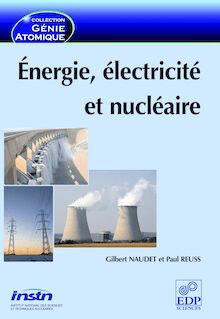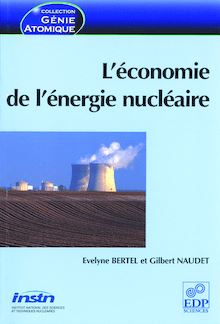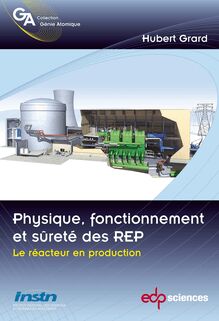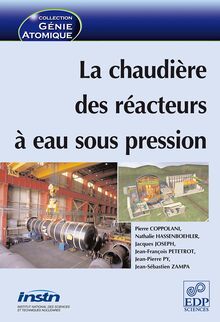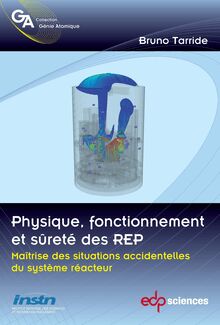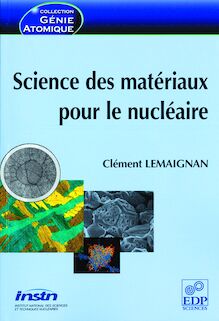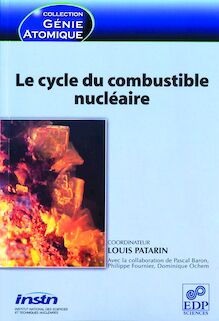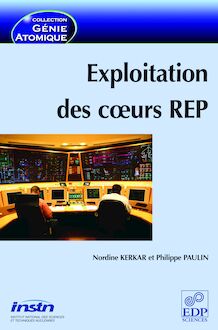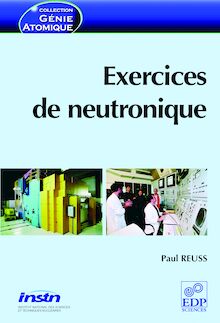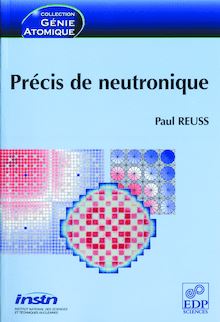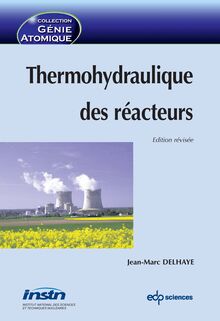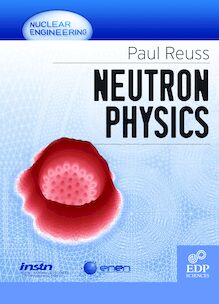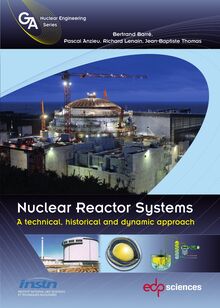Neutron physics , livre ebook
696
pages
English
Ebooks
2008
Obtenez un accès à la bibliothèque pour le consulter en ligne En savoir plus
Découvre YouScribe en t'inscrivant gratuitement
Découvre YouScribe en t'inscrivant gratuitement
696
pages
English
Ebooks
2008
Obtenez un accès à la bibliothèque pour le consulter en ligne En savoir plus
Publié par
Date de parution
01 août 2008
Nombre de lectures
2
EAN13
9782759803248
Langue
English
Poids de l'ouvrage
5 Mo
Originally just an offshoot of nuclear physics, neutron physics soon became a branch of physics in its own right. It deals with the movement of neutrons in nuclear reactors and all the nuclear reactions they trigger there, particularly the fission of heavy nuclei which starts a chain reaction to produce energy.
Neutron Physics covers the whole range of knowledge of this complex science, discussing the basics of neutron physics and some principles of neutron physics calculations. Because neutron physics is the essential part of reactor physics, it is the main subject taught to students of Nuclear Engineering.
This book takes an instructional approach for that purpose. Neutron Physics is also intended for all physicists and engineers involved in development or operational aspects of nuclear power.
Publié par
Date de parution
01 août 2008
Nombre de lectures
2
EAN13
9782759803248
Langue
English
Poids de l'ouvrage
5 Mo
@EJ
K@KLKE8
K@FE8C;<
JJ
:@<E:<
J
<KK<
:?E@HL<
JEL:Cy8@I<
JNeutron PhysicsNUCLEAR ENGINEERING
Neutron Physics
Paul Reuss
Institut national des sciences et techniques nucléaires
17, avenue du Hoggar
Parc d’activités de Courtabœuf, BP 112
91944 Les Ulis Cedex A, FranceThe author would like to thank Nova Traduction (K. Foster) and Chris Latham for the
translation of his book.
Cover illustrations: Jules Horowitz (1921-1995), a highly talented physicist, founded the French
school of neutron physics. In 2014, the Jules Horowitz reactor being built at Cadarache will become
the main irradiation reactor in the world (100 MWth) for research on materials and nuclear fuels.
In the background, the meshing for a neutron physics core calculation and in the foreground the
power distribution, result of this calculation. (Documents courtesy of CEA.)
Cover conception: Thierry Gourdin
Printed in France
ISBN: 978-2-7598-0041-4
This work is subject to copyright. All rights are reserved, whether the whole or part of the material is
concerned, specifically the rights of translation, reprinting, re-use of illustrations, recitation,
broadcasting, reproduction on microfilms or in other ways, and storage in data banks. Duplication of
this publication or parts thereof is only permitted under the provisions of the French and German
Copyright laws of March 11, 1957 and September 9, 1965, respectively. Violations fall under the
prosecution act of the French and German Copyright Laws.
c EDP Sciences 2008Introduction to the Nuclear
Engineering Collection
Within the French Atomic Energy Commission (CEA), the National Institute of Nuclear
Science and Technology (INSTN) is a higher education institution operating under the joint
supervision of the Ministries of Education and Industry. The purpose of the INSTN is to
contribute to disseminating the CEA’s expertise through specialised courses and continuing
education, not only on a national scale, but across Europe and worldwide.
This mission is focused on nuclear science and technology, and one of its main features
is a Nuclear Engineering diploma. Bolstered by the CEA’s efforts to build partnerships with
universities and engineering schools, the INSTN has developed links with other higher
education institutions, leading to the organisation of more than twenty five jointly-sponsored
Masters graduate diplomas. There are also courses covering disciplines in the health
sector: nuclear medicine, radiopharmacy, and training for hospital physicists.
Continuous education is another important part of the INSTN’s activities that relies on
the expertise developed within the CEA and by its partners in industry.
The Nuclear Engineering course (known as ’GA’, an abbreviation of its French name)
was first taught in 1954 at the CEA Saclay site, where the first experimental piles were
built. It has also been taught since 1976 at Cadarache, where fast neutron reactors were
developed. GA has been taught since 1958 at the School for the Military Applications
of Atomic Energy (EAMEA), under the responsibility of the INSTN. Since its creation, the
INSTN has awarded diplomas to over 4400 engineers who now work in major companies
or public-sector bodies in the French nuclear industry: CEA, EDF (the French electricity
board), AREVA, Cogema, Marine Nationale (the French navy), IRSN (French TSO). . . Many
foreign students from a variety of countries have also studied for this diploma.
There are two categories of student: civilian and military. Civilian students will obtain
jobs in the design or operation of nuclear reactors for power plants or research
establishments, or in fuel processing facilities. They can aim to become expert consultants,
analysing nuclear risks or assessing environmental impact. The EAMEA provides
education for certain officers assigned to French nuclear submarines or the aircraft carrier.
The teaching faculty comprises CEA research scientists, experts from the Nuclear Safety
and Radiation Protection Institute (IRSN), and engineers working in industry (EDF, AREVA,
etc.). The main subjects are: nuclear physics and neutron physics, thermal hydraulics,
nuclear materials, mechanics, radiological protection, nuclear instrumentation, operation
and safety of Pressurised Water Reactors (PWR), nuclear reactor systems, and the
nuclear fuel cycle. These courses are taught over a six-month period, followed by a final
project that rounds out the student’s training by applying it to an actual industrial situation.vi Neutron Physics
These projects take place in the CEA’s research centres, companies in the nuclear industry
(EDF, AREVA, etc.), and even abroad (USA, Canada, United Kingdom, etc.). A key feature
of this programme is the emphasis on practical work carried out using the INSTN facilities
(ISIS training reactor, PWR simulators, radiochemistry laboratories, etc.).
Even now that the nuclear industry has reached full maturity, the Nuclear Engineering
diploma is still unique in the French educational system, and affirms its mission: to train
engineers who will have an in-depth, global vision of the science and the techniques
applied in each phase of the life of nuclear installations from their design and construction
to their operation and, finally, their dismantling.
The INSTN has committed itself to publishing all the course materials in a collection
of books that will become valuable tools for students, and to publicise the contents of its
courses in French and other European higher education institutions. These books are
published by EDP Sciences, an expert in the promotion of scientific knowledge, and are also
intended to be useful beyond the academic context as essential references for engineers
and technicians in the industrial sector.
The European Nuclear Education Network (ENEN) fully supported INSTN, one of it
founder members, in publishing this book. For ENEN this book constitutes the first of a
series of textbooks intended for students and young professionals in Europe and worldwide,
contributing to the creation of the European Educational Area.
Joseph Safieh
Nuclear Engineering Course Director
ENEN PresidentContents
Foreword ...................................................................... xxi
About the Author .............xxiii
Part I Fundamentals of neutron physics
Chapter 1: Introduction: general facts about nuclear energy
1.1. A brief history .......................................................... 3
1.1.1. Fermi’s pile.... 3
1.1.2. The end of a long search... ............. 4
1.1.3. ... and the beginning of a great adventure ...................... 6
1.2. Principle of a nuclear power plant ........................... 8
1.3. Fission ..................................................... 9
1.4. Principle of chain reactions...................... 10
1.5. Main moderators and coolants; types of reactor .............. 11
1.6. Monitoring and control of reactors........................... 13
1.7. Nuclear fuel cycle .......................................... 14
1.8. Nuclear safety and radiation protection .......... 16
1.9. Nuclear programmes: prospects ................. 17
Exercises
Chapter 2: Nuclear physics for neutron physicists
A. Structure of matter and nuclear binding energy ............................... 26
2.1. Structure of matter .............................. 26
2.1.1. The classical atomic model............. 26
2.1.2. Elements and isotopes ............................. 26
2.1.3. Nuclide notation ...................... 27
2.1.4. Stable and unstable nuclei ............. 27
2.1.5. Pattern of stable nuclei ............................. 28viii Neutron Physics
2.2. Nuclear binding energy ................................................. 29
2.2.1. Mass defect and nuclear binding energy ...... 29
2.2.2. Nuclear units .............. 30
2.2.3. Nuclear forces.................................... 30
2.2.4. Liquid drop model ......... 31
2.2.5. Magic numbers and the layer model .......... 32
2.2.6. Spin and parity ................................................ 32
2.2.7. Excited levels of nuclei (isomeric states)....... 33
2.2.8. Other nuclear models...... 34
2.3. Principle of release of nuclear energy .............................. 34
2.3.1. Nuclear recombination ................ 34
2.3.2. Reaction energy ................. 35
2.3.3. Principle of fusion and fission .................................. 35
2.4.1. Regions of instability............. 38
2.4.2. Main types of radioactivity ............. 39
2.4.3. Law of radioactive decay................................. 40
2.4.4. Examples of radioactive decay.......... 42
2.4.5. Alpha instability ................. 43
2.4.6. Beta instability..................................... 44
2.4.7. Gamma instability ... 45
2.4.8. Radioactive series...................... 45
2.4.9. Radioactive series equations.............................. 45
2.5. General information about nuclear reactions ................. 47
2.5.1. Spontaneous reactions and induced reactions . 47
2.5.2. Nuclear reaction examples ..................................... 47
2.5.3. Laws of conservation............. 48
2.5.4. Cross-section .............. 48
2.5.5. Macroscopic cross-section ............................... 50
2.6. Neutron reactions............................... 51
2.6.1. General remarks ................. 51
2.6.2. Scattering and “real” reactions ................................. 52
2.6.3. Main reactions induced by neutrons in reactors ........... 52
2.6.4. Partial cross-sections and additivity of cross-sections............. 53
2.6.5. Neutron cross-section curves ............................. 54
2.7. Why resonances? ............................... 57
2.7.1. Resonant cross-sections: Breit–Wigner law.... 60
2.7.2. Resonant cross-sections: statistical aspects ...................... 64
2.7.3. Cross-sections in the thermal domain ......... 65
2.8. Neutron sources ............................................ 66
2.8.1. Spontaneous sources............. 66
2.8.2. Reactions induced by radioactivity ....
